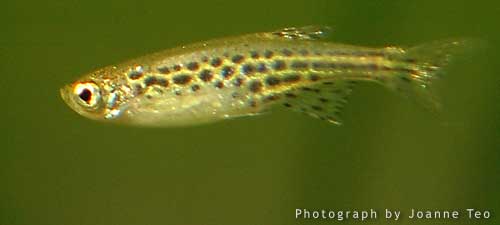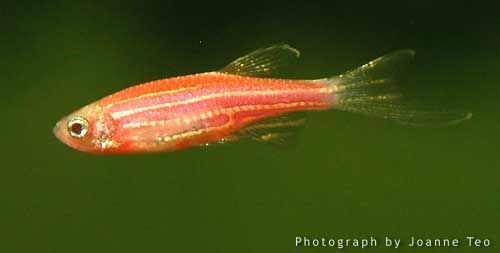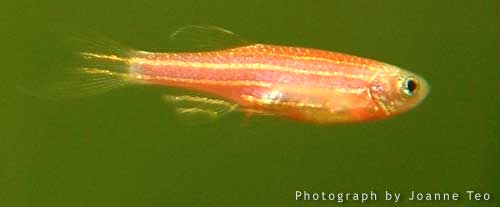I’m beginning to think, due to the colouration and markings of the boraras I got, that the fish is not actually the mosquito boraras (Boraras Brigittae) but Boraras Urophthalmoides.
My fish have the signature exclammation point marking of the Boraras Urophtalmoides. That is, a dark/black lateral stripe across the body and ending with a black dot on the peduncle (the junction of the end of the fish body and beginning of the tail). See it?
In the meantime, last night, five of those Boraras Urophtalmoides have been put into the new tank as a test to see if the water is okay.
I know one should wait between four to eight weeks to cycle the tank, but a quarter of the water was taken from the old tank and some of the gravel of the old tank was placed below the new pack of gravel and a small filter that had been placed in the old tank has been running in the new, so the tank cycling should be much faster.
Maybe not. This morning, I can only find four of the five fish I placed inside. But the tank is big and these fish are tiny. Who knows where that one is hiding.
In the meantime, I’ve also aquired a pair of Blue Ring Danios. It is sometimes called Danio sp. Burma.
Why they are called blue ring confounds me. They have no blue and the rings look like spots.
Oh well. They are pretty so I got them.
According to Wikipedia, there have been so many species danios discovered lately, that many don’t have scientific names. And many have lately been released to fish shops. With that comes massive confusion.
The guy at the fish shop had a hard time guessing the name of the Blue Ring Danio. In fact, he got this fish confused with the Long Fin Leopard Danio. They both have spots but the markings are different. The Leopard Danio has finer more regular spots but the Blue Ring Danio seem to have larger spots.
I have resisted getting the “Made in Singapore” fish, the Red Zebra Danio, a fish that has caused quite a bit of controversy because it is a conventional Zebra Danio that has been genetically modified with a gene from a sea anemone that causes it to glow under UV light.
But it is such a pretty fish on its own. Instead of a silvery fish with black stripes, this fish is red/pink with yellowish-white stripes.
This particular Danio was developed to glow when it detects pollution in water. Later, when there was commercial interest for such fish, it was released for hobbyists.
In the US, this fish is marketed under the Glofish brand.
I know that some fish get injected with dye, and I think its cruel to inject these fish with dye (that will eventually fade anyway) and so I don’t get them.
But I’m not sure about genetically modified animals. Plus they were bred for a function – to detect pollutants. So I’m not sure I’m terribly against the existence of such animals, particularly these fish.
Perhaps their existence purely in the scientific lab would not cause as much agitation amongst animal activists.
Maybe I’m just rationalising the fact that I’ve paid money for these fish, therefore perpetuating the practice of genetically modifying fish for no reason other than aesthetic enjoyment.
Whatever the case, all I know is that I do not release domesticated animals in the wild.





2 Replies to “Boraras confusion, the danionin influx and Glofish”